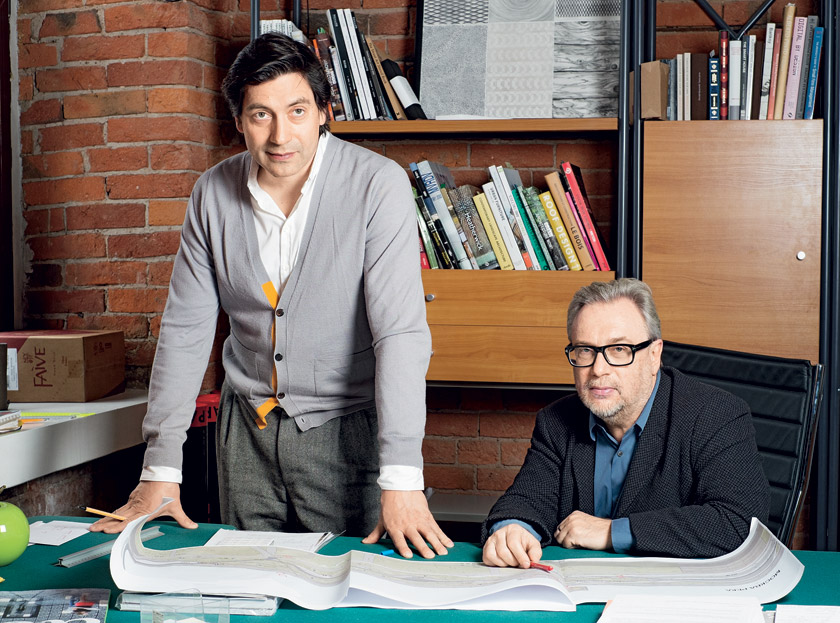Dmitry Likin: Choose a profession according to the lifestyle it comes with

Not all people who got special architectural education sit in project offices drawing plans. Dmitry Likin, Wowhaus partner and the main artist of the First Channel is the man who does not quit the architectural profession, and at the same time successfully implements his talents in creative industries.
Dmitry Likin was one of the most interesting guests of «Open City» Conference; so we decided to publish the full quotes from his speech during Elena Gonzalez’ session «Career path».
One should choose a profession according to the lifestyle it comes with
When I was going to enter a university, I don’t remember exactly what was there in my mind — maybe something about Frank Wright and some modernist names, like Eisenmann, that were in fashion at that time. Now, when a person is going to take up something, he is also dreaming of different names: I’ll become a designer who will create such a perfect image of the future, which is so ‘smooth’ and so ‘intelligent’, followed by all the words that are commonly used in presentations.
And then you begin to explain that design is not ‘smooth’, it’s 80 thousand hours, which you’ll spend sitting with hunched back in front of a monitor — and that is what your life will really consist of.
If your internal motivation happens to outweigh everything that is associated with this type of lifestyle, then take up design. But there are few people like this. Most beginners quit it, unless they are really crazy and ‘combinations of curvature’ mean so much to them.

The same happens with architecture. I can’t do the same things every day. I really admire my colleague-architects who every day are doing this ‘hard ware’ that the profession consists of. But I can’t imagine in all seriousness that I’d have to kill a whole week of my life drawing a combination of this stone with that window. I’d want to die. That’s not my cup of tea.
I’m interested in architecture, but not actually doing the ‘flesh’ of architecture — and it is important to understand that this profession in general consists of the things like this
The profession does not consist of what you’re told at conferences when they’re inventing these wonderful new purposes, beautiful scenarios, etc. The reality is that you spend a lot of time doing detailed calculations, drawing, checking and making some models. If for some reason you’re interested in this, you can do it. If you know that your disposition is a little different, don’t deceive yourself, you shouldn’t go in for this sort of thing.
Once, at a teacher-parent meeting in the English college that my daughter graduated from, they told us, ‘Dear parents, here in England we lack a lot of things — we are afraid we don’t have enough people who can bake bread or work as nurses, we have few air traffic controllers — we have to hire them from Switzerland and pay them so much money. But we certainly have no problems with creative workers, such as designers, architects, that seem to be countless here; because everyone wants to have a nice job, in a nice office, and say nice words to the clients.

Try to understand that no one will drag your kids by the ears. We swear that we will answer all their questions, but if they don’t ask them, we aren’t going to provide guidance to them.
Being an employee of creative industries is a privilege that must be deserved
This is the radical difference between the English approach and Russian one, where we pull students by the ears and give them noogies — «Come on, you wimp, pull yourself together and go to a seminar, participate in a colloquium...» In England this situation is different — there you have to deal with it on your own, which seriously helps to shape the character of the people that pass through this filter; this quite cruel system puts a child from the beginning in a highly competitive environment where he has to be not only smart and talented, but also creative, and take control of his life.
Last year I taught a course at MARCH School and was amazed at the fact that the students who were going to get their master’s degree, i.e. those who were masters of architecture, could not organize themselves and were 40 minutes late to class. In that moment, when you see that pampered creature who, having once paid some money, which is likely his dad’s (because you look at him and realize that he has not earned any yet), is going to become a creative unit; and then he would come and say, «Well, I want a hundred thousand per month, because I attended two colloquiums and graduated from MARCH» — you immediately feel like giving him some task to see how he will cope with it.
And if he manages to organize himself, put a premium on the workflow instead of his permanent interests, and complete this training course, and it turns out that the person, in addition to his creative abilities, has a strong will and can control himself and others, which, I must say, is purely architectural ability, — then you’re welcome to ‘join the club’, you meet the requirements, and can begin to work with us, you’re a real architect.

Dmitry Likin and Oleg Shapiro, Wowhaus partners
I agree that the basic capability of the architect is directing, structuring the chaos and struggle against entropy
In my opinion, now we have abandoned very important issue when choosing a career. What one should think about before entering the university — about designing the chaos when you’re ready to spend many days working on a project, or about a lifestyle, something pleasant, like presentations and parties? If the latter, then you shouldn’t become an architect; it is a great education, but it is not about that at all.
If education allows you to move forward — move!
About artists
It is important to understand who you are, an artist or art-director. The difference is that the artist constantly presents himself, he carries his talent to people, a city and the world; the artist always wants to express himself. In extremum, it is a person who believes that his every sneeze is worth a decent memorialization. There are a lot of people like this — from Michelangelo to Nikas Safronov. They are all of different quality, but they are all true artists.
An art-director is the person who builds self-identity around the brain, the process of control, rather than around the talent. An art-director never presents himself, he only responds to the challenges of the situation. These are two different professions. Acting as art-director, you begin your realization under the specified circumstances, and you understand that your professional credo is to provide the most professional respond to the circumstances, rather than impose your own vision on the customer.

After that, which often happens, you get to the next stage — a producer, who starts to form the circumstances under which you have to work. It’s not a hierarchy, and neither qualitative, nor in any case quantitative development, but it is most likely the person’s nature that can’t sit still. As far as I’m concerned, once I realized that I’m more interested in manipulation of circumstances and implementation of some greater communication processes.
In my case there are quite a lot of them — I’m still involved in some processes related to art, for example, «Movie Time» Exhibition opened recently, which I implemented on request of VDNH. I spend quite a lot of time on media.
Everything that distinguishes TV from radio, everything you see on the First Channel, except appearance of presenter hosts — is my competence
I’m interested in architecture as a media, and not because of its plastic language. I did a lot of tasks, ranging from the Crimean embankment, Strelka Institute, Pioneer Cinema to many others.
Personally, I don’t really care what to do. I don’t consider myself an artist, so, generally speaking, I take easy my colleagues’ attitude towards me, who are true artists. I have no right to claim the fame of the real artist, whose picture or author’s gesture is worth some kind of incredible promotion. But the advantages of my position are that I like ‘Kolobok’ can migrate in Moscow conceptual school from one field to another, avoiding dead areas of ‘recognition’ and ‘fixation’.
- Tags:
- education




